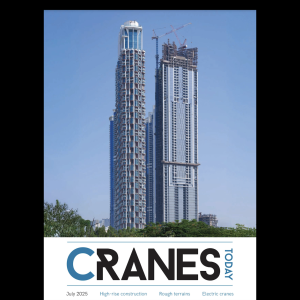At 21 miles (33.8km) long and $2.3bn, Orlando’s massive I-4 Ultimate is the largest infrastructure project in the Florida Department of Transportation’s (FDOT) history. By the time the last yard of concrete is placed in 2021, the project will consume 6.7 million cubic yards (4.8 million m3) of fill material, require 1.74 million linear ft (530,350m) of bridge, overpass, ramp, and structure piles, have 2.25 million sq ft (209,030m2) of bridge deck paved and use 591,250 cubic yards (16,740m3) of concrete.
Divided into four phases, the project will require monumental bridge work to improve traffic flow through the heart of Central Florida. Thirteen existing structures will be widened, 53 new bridges added and 74 bridges replaced. Area 2, currently under construction, dissects downtown Orlando from Highway 50 at the northern edge to the Highway 423/I-4 interchange at its southernmost part.
“We will be adding or reconstructing 40 structures in this area,” said Vern Nix, owner of V&M Erectors, of Pembroke Pines, Florida. “We need to place 50 million pounds (22,680t) of steel for this phase of the contract.”
In addition to being the largest infrastructure project in Florida, the I-4 Ultimate project ranks among the most complex and congested sites for bridge building. Area 2 comprises of multiple high-level flyover ramps, which makes accessing the site challenging.
“It’s a difficult project to deal with the traffic flow and existing structures, and it is very congested,” Nix commented. “The erection scheme includes tight coordinates to place the girders into location. This requires us to set-up, tear-down and move the cranes a lot.”
Bridge length in Area 2 averages 2,000 to 3,000ft. Rather than working at night to place girders, V&M and the Florida DOT are using 40- to 56-hour road closure times to improve bridge construction efficiency and limit impact on traffic. “We install an average of 9 to 15 girders over an existing road, so it makes it much more efficient for all trades if we close the road over a weekend versus working on it over 10-plus nights,” said Nix.
The work schedule requires V&M to quickly move from bridge to bridge, and each bridge consists of one to five units. Within each bridge unit, workers must move the cranes three to four times.
V&M chose to use all three of its Terex HC crawler cranes on the project – the HC 230, the HC 275 and the recently-purchased HC 285.
Throughout Area 2, V&M will equip its three HC cranes with boom configurations ranging from 140 to 200ft and will work at radii where the lift chart offers capacities from 150,000 to 200,000lb (68 to 90.7t). Workers preassemble two sections of girder on the ground before hoisting up to 200ft-long sections that weigh up to 200,000lb.
For maximum capacity, the cranes are rigged in their full counterweight configurations. Additionally, a luffing jib is kept on site to assist lifting the preassembled girders over structures. “In this congested area, we cannot boom down enough, so we need the jib at times,” added Nix.
There are times during the installation process, such as on the recently completed bridge number 225, when the cranes are required to hold in place up to 600ft of linear beams, weighing a combined 600,000lb. This is when V&M calls on a standby Demag AC 700 all terrain crane owned by Pompano Beach’s Hunter Merchant.
The AC 700 has a compact undercarriage length of only 61 ft (18.6 m), allowing it to efficiently work fit in the congested Area 2 spaces.
On the complex bridge number 225, V&M paired the smaller HC 230 and 275 cranes in tandem lifts, while the larger HC 285 crawler and AC 700 all terrain cranes were reserved to support the heavier girder spans. This gave crew members the capacity required to connect these long flyover spans between piers while supported at elevation.
It’s been nearly two years since Nix and V&M began and completed the steel bridge work on Area 1 of the I-4 Ultimate project. The company has about another two years of work on Area 2.






